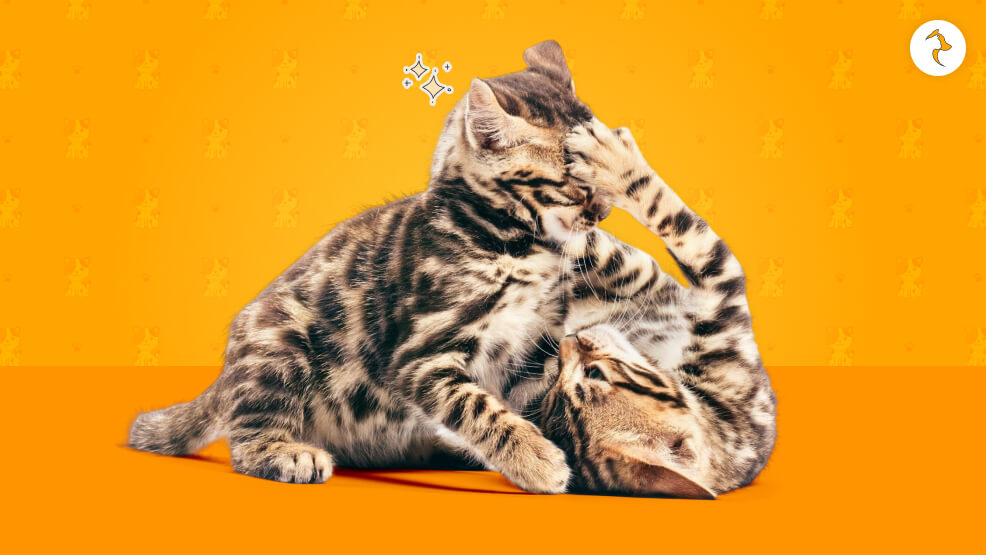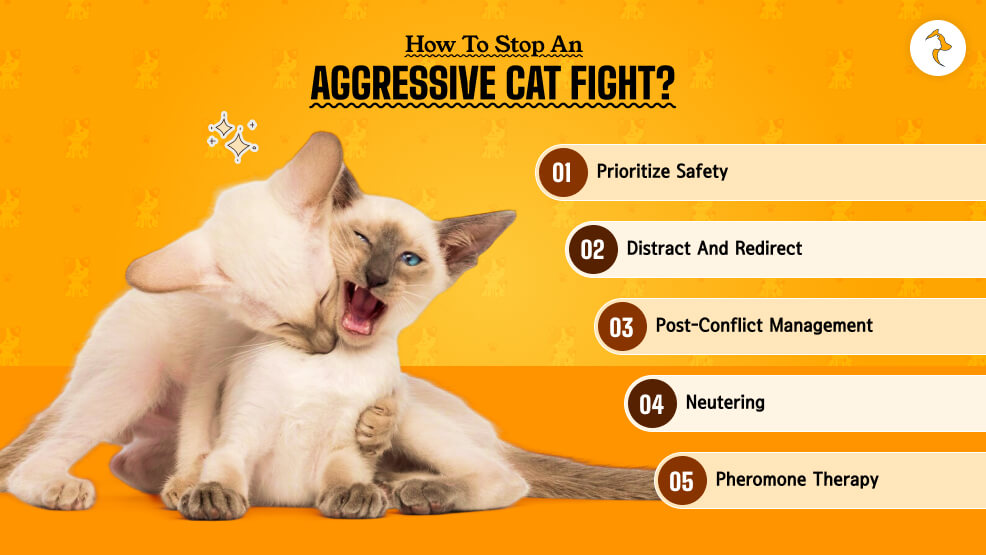How To Tell If Cats Are Playing Or Fighting: Do They Not Get Along?


Last week, I woke up in the middle of the night from the sounds of the cats fighting. Then I stood there for a while and thought, are my cats playing or fighting?
I am not the only one who thinks this way. It might be difficult to decode cat behavior in the beginning, but you will get the hang of it eventually and decide what they are trying to say.
The dynamics in a multi-cat household are complicated. These fur balls have different relationships with one another in the house, depending on their personalities and behavior. So, how to tell if cats are playing or fighting?
How To Tell If Cats Are Playing? What Are The Signs?

How will you know if your cats are playing? Here are some of the major signs to look out for if your cats are playing.
1. Vocalizing
When cats are playing, they do not communicate or vocalize. There is very little vocalizing involved. However, you might notice some chirp sounds or short meows.
Also, you might hear a few small growls or hisses indicating they are playing, even if one of your fur babies is getting a little too rough.
2. Physical Contact
You will notice them making a lot of physical contact when they are playing. They grab their friends by their limbs and tackle them. Moreover, you will even kick and bite one another, especially around the neck.
The best thing is, you will notice them swapping positions. The one on top will get in their back to reverse roles. They will show slow movements and try not to hurt one another.
3. Initiating
You will notice cats taking turns when they are playing. They mostly pounce, crouch, and stalk their playing partner.
4. Follow Their Ears And Tail
If a cat is playing, you might notice their ears pointing forward or backward. Additionally, their tails appear smooth and slightly puffed up when they are playing.
5. Chasing
When a cat chases their fellow friends, don’t do it to drive them away. Moreover, they want to keep playing with them. They will take turns and swap roles, rather than just one cat chasing the other.
6. Swiping
Cats take turns at patting, swiping, and batting at one another. Also, you will notice them retracting their claws to avoid hurting their friend.
7. Biting
They do not use all their strength to bite their friend. They do not playfully avoid causing injury and breaking the skin of their friend. Cats often try to take the head of their friend in their mouth and bite, but not to hurt them literally.
8. Distracting
When they are playing, you will be able to distract them easily. They will be easily distracted by a noise or any other activity from any corner of the room.
9. Afterward
This is something you will notice when the episode is over. If the cats were playing, they would want to stay close to each other or sit next to one another. Moreover, they will groom each other or might even fall asleep together.
10. Injuries
Cats generally don’t injure their friends when they are playing. It is rare to cause injuries like scratch marks, bite wounds, and bleeding.
How To Tell If They Are Fighting? What Are The Signs?

How to tell if cats are playing or fighting? When they are fighting, they will engage in the same activities they did while playing, but their intention and approach will be different.
1. Vocalizing
How to tell if a cat is playing or angry? You can have an idea from the way they vocalize. When they are fighting, they will be a lot more vocal. They will shriek, scream, yowl, and hiss during a fight.
2. Physical Contact
Cats often plunge towards the other after staring at them for a while. They yowl with tense body postures.
When they are involved physically, they make quick movements, and they do not back down from hurting them. They attack aggressively. They often dive in the air while kicking, biting, and scratching one another.
3. Initiating
When cats fight, they do not take turns initiating it. You will find one of your cats constantly pursuing the other.
4. Follow Their Ears And Tail
When a cat is fighting, you will notice that its ears flatten or point backward. Moreover, their tails get completely puffed when they are fighting.
5. Chasing
This is not like those playful chases. They will be aggressive and harass each other during fights. When they are attacking, a chase will be a means of escape, with one of your fur babies fleeing and the other chasing behind them.
6. Swiping
They extend their claws and swipe at one another to cause damage. There is no being considerate when they are in the mood to fight.
7. Biting
During fights, cats bite to hurt their fellow friend. There is no holding back at that moment. You might even find them breaking the skin of the other one with their teeth.
8. Distracting
When cats fight aggressively, they become aroused. You will not be able to distract them with any activity or noise, even if you stand close to them.
9. Afterward
After a fight, cats cannot relax immediately. They remain aroused for a while. They would not like to stay close to one another if that were actually a fight.
10. Injuries
If they are fighting, you find them scratching one another, bite would around their body, and definitely some fur loss if the fight was aggressive.
How To Tell If Cats Are Playing Or Fighting? How To Tell If Cats Are Friends Or Enemies?

Another thing that can help you understand whether your cats are actually playing or fighting is by observing their behavior daily.
You should keep an eye on how they generally behave around one another. Here are some signs that can help you understand.
| Serial No. | Signs They Get Along Well | Signs They Are Hostile |
|---|---|---|
| 1 | They groom one another without it turning into a fight. | Avoiding eye contact when they meet is a major sign. Their pupils dilate, tails swish, and their ears point backwards. |
| 2 | You will notice them rubbing their cheeks against one another. | They keep a distance and take turns while using space and resources. |
| 3 | Their bodies touch when they are sleeping. | They often share the same resting place, but their bodies will not touch. |
| 4 | They share space and resources. | Sharing space and resources is not their thing. |
| 5 | They greet one another with their tail and ears up. | One of your cats may sneak around to access food and initiate unwanted interactions. |
| 6 | They roll their backs in front of one another. | They don’t actively avoid one another, but don’t seek each other out as well. |
How To Stop An Aggressive Cat Fight?

Now that you know how to tell if cat is playing or angry, it is time to understand how to stop them when things start to look like they are getting out of hand. Here are some of the ways you can stop cats fighting aggressively.
- Prioritize safety: Never try to pull your cats apart or put your hand between them. Keep your distance.
- Distract and redirect: Try to distract them with a sudden loud noise and break their focus. Moreover, you can wave a large object or use a treat or toy to get their attention.
- Post-conflict management: If this is something that is frequent, you can separate them into different areas and separate their resources. Moreover, try to understand the cause of fighting, and if things persist, then contact a vet to understand their behavior.
- Neutering: Spaying or neutering is known to reduce aggressive behavior. This is more common in male cats.
- Pheromone therapy: Use different pheromone sprays or diffusers. This helps reduce tension and stress in cats.
Frequently Asked Questions
Here are some frequently asked questions that people ask when discussing how to tell if kittens are playing or fighting. Here are the questions mentioned.
It is common for younger cats and kittens to engage in playfighting. They do this to develop their fighting and hunting skills. Moreover, they learn to attack and defend themselves.
Indoor cats can suddenly start fighting due to changes in their environment, territorial disputes, illness, or stress. If they get along well but start fighting suddenly, it is best to consult a veterinarian, as it could be due to a health issue or stress.
You need to pay attention to their body language to understand whether they are being aggressive or playful. Playful cats have a relaxed posture and make playful sounds. Whereas aggressive cats are tense with dilated pupils, flattened ears, and use aggressive vocalization.
It is normal for cats to bite when they are playing. Play-biting is common in cats and kittens. This is also another way for them to sharpen their hunting skills. They mean no harm and will not cause serious damage to the other.
Did You Match Them Right?
Pairing them right is an important factor. If you’re wondering how to tell if cats are playing or fighting, the answer may lie in this match.
If one of your cats is playful and the other is not, it’s best to spend some time with the high-energy one. This will help the other one relax and relieve the pressure, as they are becoming the target every once in a while.









Leave A Comment